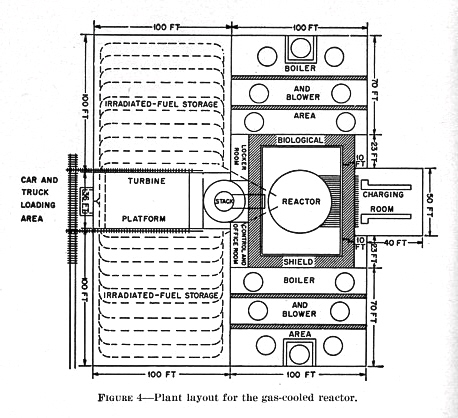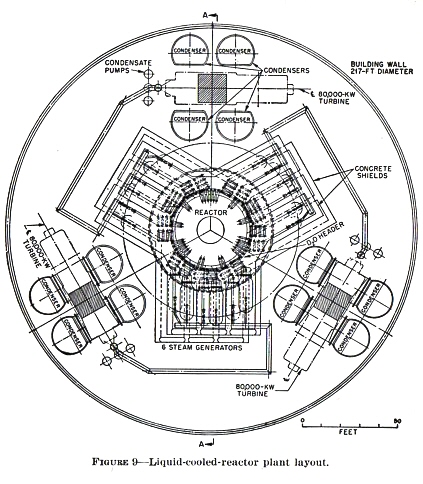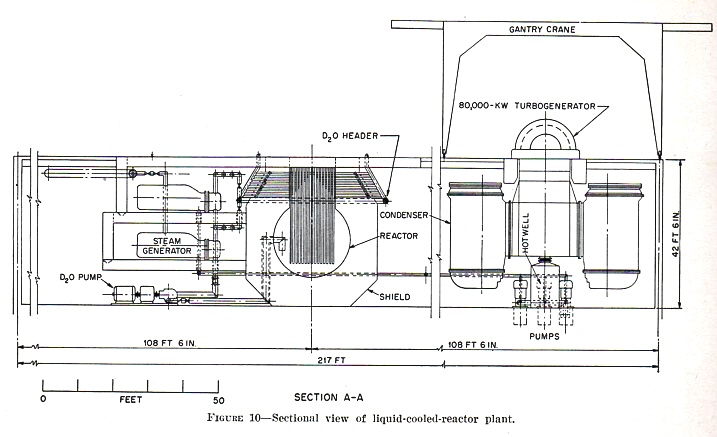Nuclear Power Reactor Technology, 1950-1953 (Part 1)
In 1950, there were few nuclear reactors of any sort operating anywhere in the world, even though it had been eight years since the startup of the very first pile. In that intervening time, the Manhattan Project had given way to the U.S. Atomic Energy Commission (AEC) and a variety of reactor types were discussed, debated, designed, and scheduled. None of these was what we today would call a true commercial nuclear plant-built for the purpose of selling electricity to customers. Instead, they were test types, prototypes, and experimental or research types. Large reactors were running at Hanford; these did not produce electricity, but rather plutonium for AEC weapons programs. Atomic energy was still considered far too undeveloped for serious consideration as a straight commercial power producer, and private industry was still barred from most all activities in the nuclear industry, embryonic as it was.
In the summer of 1950, Dr. Charles A. Thomas of the Monsanto Chemical Company approached the AEC with an idea. It was suggested that private industry might be able to get involved, initially, in the reactor business using private money by designing and building nuclear plants that would both produce plutonium for weapons (which the AEC would then purchase) as well as electricity to be sold commercially. The AEC was interested but did not act immediately.
An unrelated solicitation was shortly received by the AEC from the Dow Chemical Company; the AEC then asked for other proposals along these lines with the clear point of holding a formal study or design competition. By the summer of 1951, four groups had agreed with the AEC to conduct studies of such plants (plutonium and power production, that is) at their own expense.
The details of these studies, as well as the history above, are revealed in a remarkable document entitled "Reports to the US Atomic Energy Commission on Nuclear Power Reactor Technology," published by the AEC in May 1953. The studies were performed over two years, and the AEC estimated that the total outlay of private industry was roughly $1 million dollars. Some studies were more detailed than others; all contributed to the AEC's understanding of what private industry believed was possible.
Classified information was transferred to the participating groups in a highly controlled manner in order that they be able to properly assess the technologies available and perceived possible. This transfer long pre-dated the CAP or Civilian Application Program of 1954 and constituted the first real opening of military and national lab derived information to the private sector relative to commercial power production.
We will take a brief look at the four groups and what their studies determined in this article and following ones.
Group One: Commonwealth Edison Company and Public Service Co. of Northern Illinois
This group studied both a gas cooled, graphite moderated reactor (chosen first by the group since more information about this type was available in the literature provided to it) and a heavy water cooled and moderated type that was felt promising at that time by Argonne National Laboratory.

Commonwealth Edison / Public Service Co. design for gas cooled nuclear power plant.
The design shown above would have used 985 tons of graphite in the core and another 500 outside; the fuel would have been uranium metal slugs with fins applied, and helium was to be the coolant at a pressure of 10 atmospheres. The core rating was 350 MWt, and the concept allowed online refueling. (See "charging room" on drawing above.) Heat was to be transferred using 12 "boilers," today called steam generators, although the design specified that 10 were sufficient for full power. The turbine generator would have been 61.7 MWe, with the plant requiring 15 MW for plant services leaving a net power generation of 46.7 MWe to the be sold (to the grid).
The group also considered a very large (for the day) heavy water cooled and moderated nuclear plant.
A single, large reactor rated 1,064 MWt was to provide power to drive three separate turbine generator sets; the reactor was planned to have 211 individual fuel element and control rod D2O headers feeding hot water into a 21-foot-radius ring header circumscribing the reactor. This 18-inch header was connected to 18 12-inch headers, running off of it, which led to the 18 steam generators (six to a power circuit). Each steam generator was to produce 180,000 lbs per hour of steam at 180 p.s.i.a.

 Above, top and sectional view of proposed heavy water cooled and moderated plant. Top view clearly shows three turbine generator sets; section view shows only one of the three for clarity.
Above, top and sectional view of proposed heavy water cooled and moderated plant. Top view clearly shows three turbine generator sets; section view shows only one of the three for clarity.
The total power output of the three turbines, net to the grid, was to have been 211.5 MWe. The plant was intended to use a control scheme featuring a constant reactor outlet temperature, and was to vary total heat generation by variation in coolant flow. Constant steam pressure was to be maintained, and bypasses ("dumps") to the condensers around the turbine were included.
It was estimated that 40 percent of the plant cost for this design would be the heavy water, while 20 percent would be for the reactor, its coolant system, the controls, and land and site development. "The remaining 40 percent approximates the cost of the parallel plant components of an equivalent steam turbogenerator plant," according to the participants.
The study participants made a set of observations about economics of these proposed plants, which they said "made economic appraisal difficult." The very early state of the industry 1951-1953 is best judged, perhaps, in careful consideration of each of these points:
1. No one has had any experience with the building or operation of dual-purpose large scale reactors, and, of course, there is no precedent for the separate evaluation of their plutonium and power-producing costs.
2. The AEC construction and operation costs of existing production reactors are difficult to translate into terms of utility plant and cost-accounting practice.
3. Obsolescence and other fixed charge rates for major plant components in a new and rapidly developing field of technology must be estimated without any basis of past experience.
4. The capital investment in the heat source and plant components necessary to make the heat available to conventional energy conversion components would be greater than in conventional plants.
5. Private ownership of a reactor and fissionable material, its fuel, is not permitted under the Atomic Energy Act of 1946.
6. (Paraphrased for brevity) The economics and scheduling of AEC purchase and reprocessing of fuel in such an operation cannot be estimated.
7. (Paraphrased) The plant owner would be at the mercy of the AEC for fuel supply and under its control for utilization of such fuel.
The final result of the study was that the pair selected the heavy water cooled reactor as having the best economic possibilities, using their words. It was expected that if enriched uranium fuel became available, that a shift to light water could offer "considerable advantage"-noting that 40 percent of plant cost was the heavy water.
It was reported that after initiation of a project to build the reactor, construction could start in the middle of the second year or at the start of the third year; trial operation could begin about three years after project initiation. These were bold promises indeed given the economic considerations' implications.
Next time: The next proposals from industry to the Atomic Energy Commission.
You might also like:
Atomic Power for Peace, Part 1
Atomic Power for Peace, Part 2
Atomic Power for Peace, Part 3 - CAP and Power Demonstration Reactors
ILLUSTRATIONS from "Reports to the US Atomic Energy Commission on Nuclear Power Reactor Technology," US AEC May 1953
____________________________________________________________
 Will Davis is Communications Director and board member for the N/S Savannah Association, Inc. He is a consultant to the Global America Business Institute, a contributing author for Fuel Cycle Week, and writes his own popular blog Atomic Power Review. Davis is also a consultant and writer for the American Nuclear Society, and serves on the ANS Communications Committee. He is a former US Navy reactor operator, qualified on S8G and S5W plants.
Will Davis is Communications Director and board member for the N/S Savannah Association, Inc. He is a consultant to the Global America Business Institute, a contributing author for Fuel Cycle Week, and writes his own popular blog Atomic Power Review. Davis is also a consultant and writer for the American Nuclear Society, and serves on the ANS Communications Committee. He is a former US Navy reactor operator, qualified on S8G and S5W plants.

